Physical Address
304 North Cardinal St.
Dorchester Center, MA 02124
Primary neoplastic lesions of the kidney can be divided according to the age groups of affected patients. Renal tumors in children generally resemble the nephrogenic tissues of embryogenesis and include nephroblastoma (Wilms tumor) and clear cell sarcoma. Renal cell carcinomas (RCCs) are the major neoplasia of the kidney in adults. They have been classified on the basis of their histologic appearance, but studies have determined that they also can be stratified according to cytogenetic characteristics, as seen in the 2016 World Health Organization (WHO) classification that includes several new entities. These are summarized in Table 10.1 . In addition to the tumors involving the renal parenchyma, the collecting system is also subject to neoplasias, which histologically fit into the same categories as those involving the ureters and bladder and are variants of urothelial (transitional cell) carcinoma. The exception is the highly aggressive collecting duct carcinoma, which shows medullary location, tubular architecture, desmoplastic stromal reaction, and high-grade atypia and does not show features of renal cell carcinoma or urothelial carcinoma.
| Renal cell tumors | |
|---|---|
| Clear cell renal cell carcinoma | 8310/3 |
| Multilocular cystic renal neoplasm of low malignant potential | 8316/1 a |
| Papillary renal cell carcinoma | 8260/3 |
| Hereditary leiomyomatosis and renal cell carcinoma–associated renal cell carcinoma | 8311/3 a |
| Chromophobe renal cell carcinoma | 8317/3 |
| Collecting duct carcinoma | 8319/3 |
| Renal medullary carcinoma | 8510/3 a |
| MiT family translocation renal cell carcinomas | 8311/3 a |
| Succinate dehydrogenase-deficient renal cell carcinoma | |
| Mucinous tubular and spindle cell carcinoma | 8480/3 a |
| Tubulocystic renal cell carcinoma | 8316/3 a |
| Acquired cystic disease–associated renal cell carcinoma | 8316/3 a |
| Clear cell papillary renal cell carcinoma | 8323/1 |
| Renal cell carcinoma, unclassified | 8312/3 |
| Papillary adenoma | 8260/0 |
| Oncocytoma | 8290/0 |
| Metanephric tumors | |
| Metanephric adenoma | 8325/0 |
| Metanephric adenofibroma | 9013/0 |
| Metanephric stromal tumor | 8935/1 |
| Nephroblastic and cystic tumors occurring mainly in children | |
| Nephrogenic rests | |
| Nephroblastoma | 8960/3 |
| Cystic partially differentiated nephroblastoma | 8959/1 |
| Pediatric cystic nephroma | 8959/0 |
| Mesenchymal Tumors | |
| Mesenchymal tumors occurring mainly in children | |
| Clear cell sarcoma | 8964/3 |
| Rhabdoid tumor | 8963/3 |
| Congenital mesoblastic nephroma | 8960/1 |
| Ossifying renal tumor of infancy | 8967/0 |
| Mesenchymal tumors occurring mainly in adults | |
| Leiomyosarcoma | 8890/3 |
| Angiosarcoma | 9120/3 |
| Rhabdomyosarcoma | 8900/3 |
| Osteosarcoma | 9180/3 |
| Synovial sarcoma | 9040/3 |
| Ewing sarcoma | 9364/3 |
| Angiomyolipoma | 8860/3 |
| Epithelioid angiomyolipoma | 8860/1 a |
| Leiomyoma | 8890/0 |
| Hemangioma | 9120/0 |
| Lymphangioma | 9170/0 |
| Hemangioblastoma | 9161/1 |
| Juxtaglomerular cell tumor | 8361/0 |
| Renomedullary interstitial cell tumor | 8966/0 |
| Schwannoma | 9560/0 |
| Solitary fibrous tumor | 8815/1 |
| Mixed epithelial and stromal tumor family | |
| Adult cystic nephroma | 8959/0 |
| Mixed epithelial and stromal tumor | 8959/0 |
| Neuroendocrine tumors | |
| Well-differentiated neuroendocrine tumor | 8240/3 |
| Large cell neuroendocrine carcinoma | 8013/3 |
| Small cell neuroendocrine carcinoma | 8041/3 |
| Paraganglioma | 8700/0 |
| Miscellaneous tumors | |
| Renal hematopoietic neoplasms | |
| Germ cell tumors | |
| Metastatic tumors | |
Papillary adenomas are unencapsulated small (≤15 mm in diameter) papillary epithelial proliferations ( Fig. 10.1 ). They are seen frequently in older patients and in patients with end-stage renal disease (ESRD) undergoing dialysis with acquired cystic disease. Papillary adenomas are also found concurrently with papillary RCC, suggesting that they may be precursors or part of a continuum of progression to malignancy. Papillary lesions greater than 15 mm are classified as papillary renal cell carcinomas, which are often well circumscribed and encapsulated. Of note, the true size and presence of a fibrous capsule of a papillary lesion partially represented in a kidney core biopsy may not be discernible, and absolute classification then cannot be made.
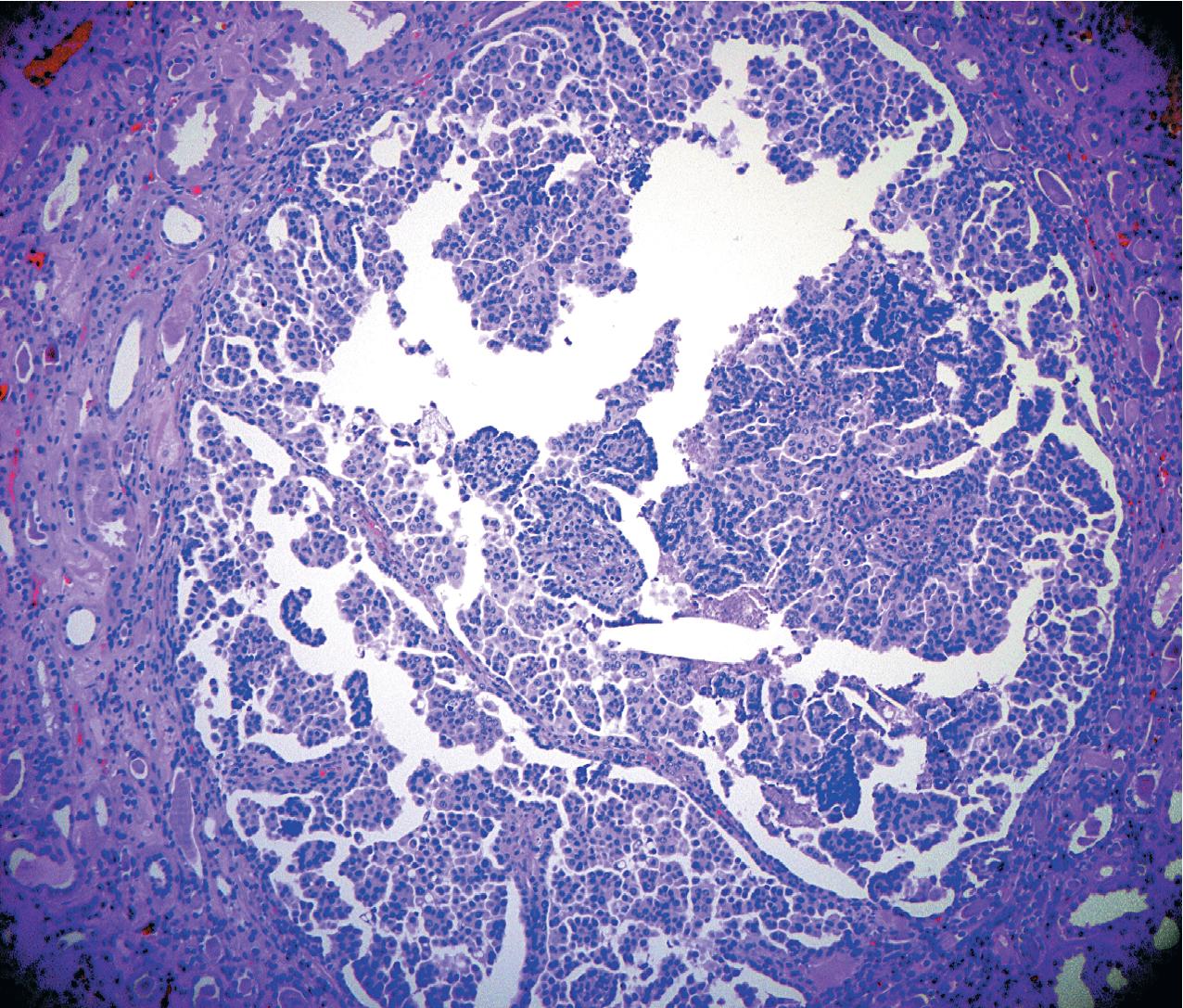
Renal oncocytomas are believed to arise from the intercalated cells of renal collecting tubules. Patients are generally asymptomatic at the time of diagnosis, with their tumors discovered incidentally during investigation of hypertension, hematuria, and/or flank or abdominal pain. These tumors are typically well-circumscribed, mahogany-brown solid tumors of variable size with a central scar commonly present. Microscopically, they are composed predominantly of round to polygonal cells with densely granular eosinophilic cytoplasm, round uniform nuclei with smoothly dispersed chromatin, and a central nucleolus embedded in a hyalinized or myxoid stroma ( Figs. 10.2–10.5 ). Ultrastructurally, tumor cells have basal lamina; rarely, intercellular or cytoplasmic lumina; and apical, short, stubby microvilli. The cytoplasm is closely packed with mitochondria showing lamellar or focally stacked cristae (see Fig. 10.4 ).
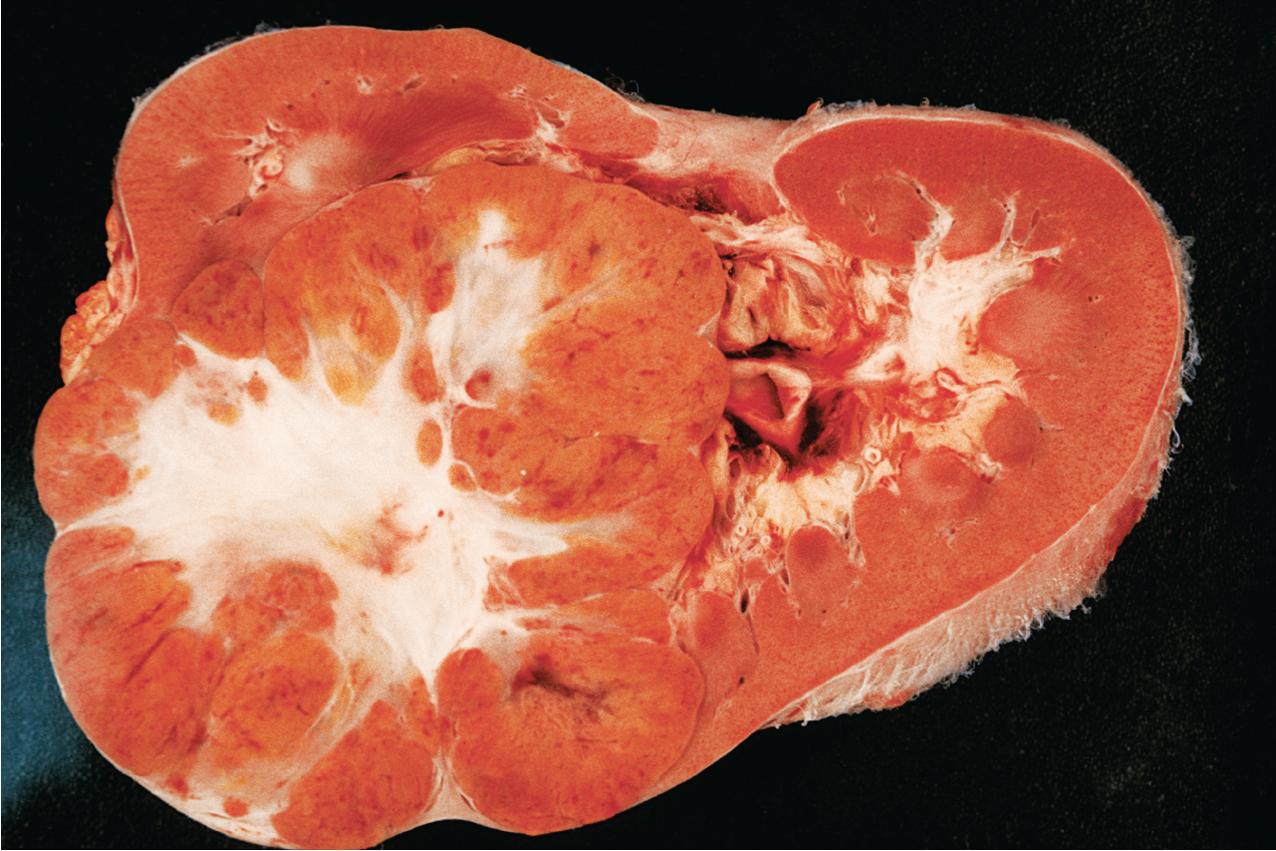
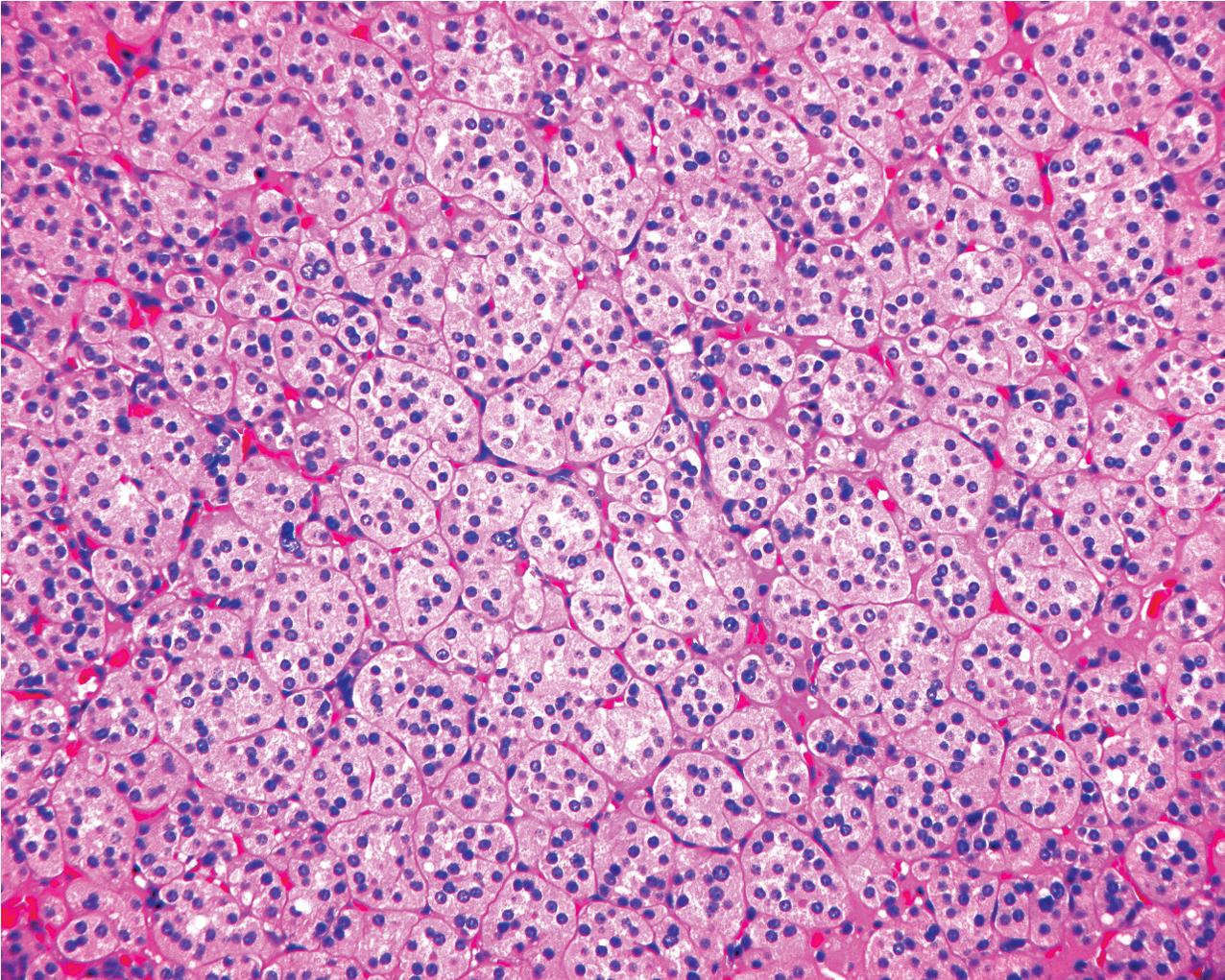
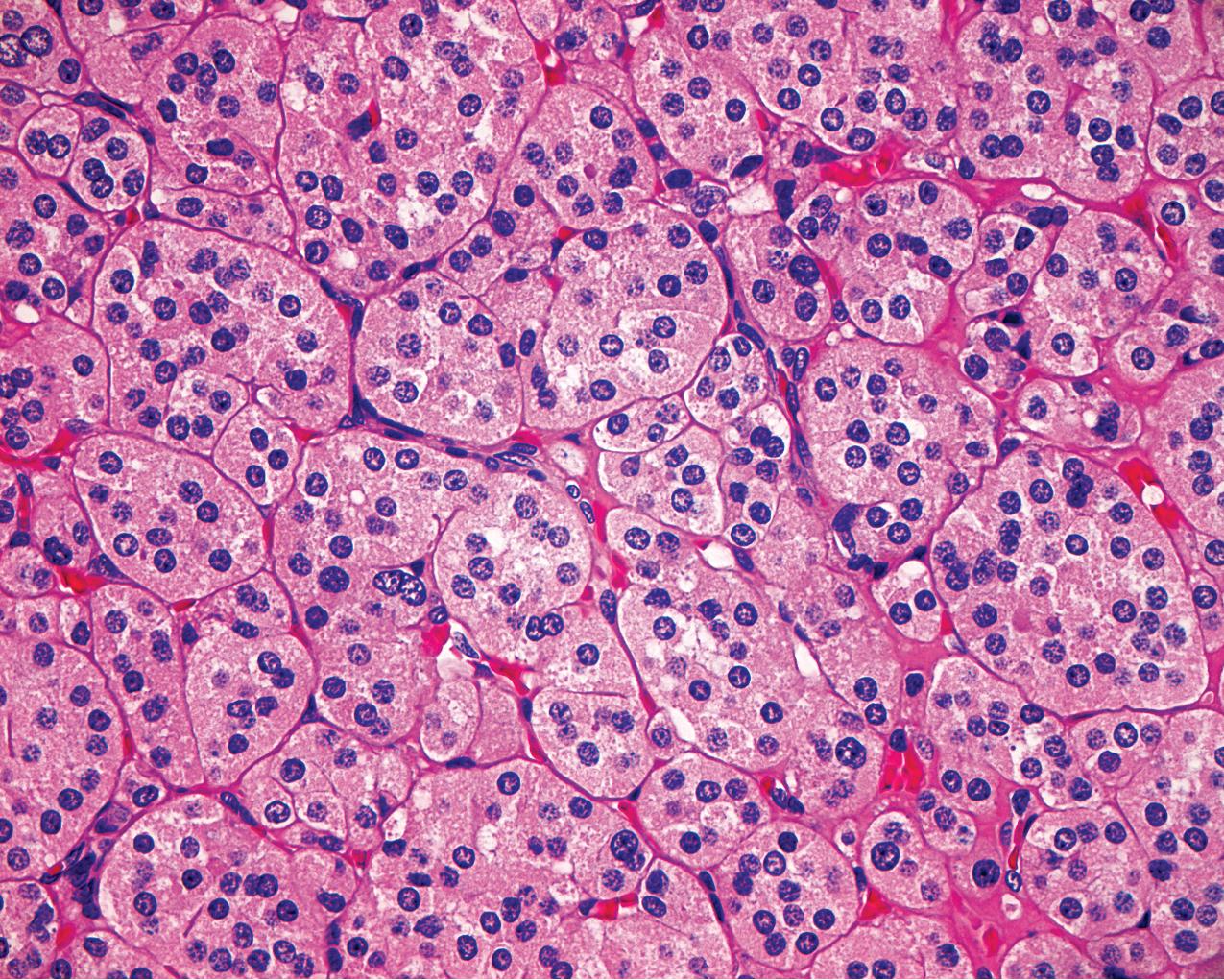
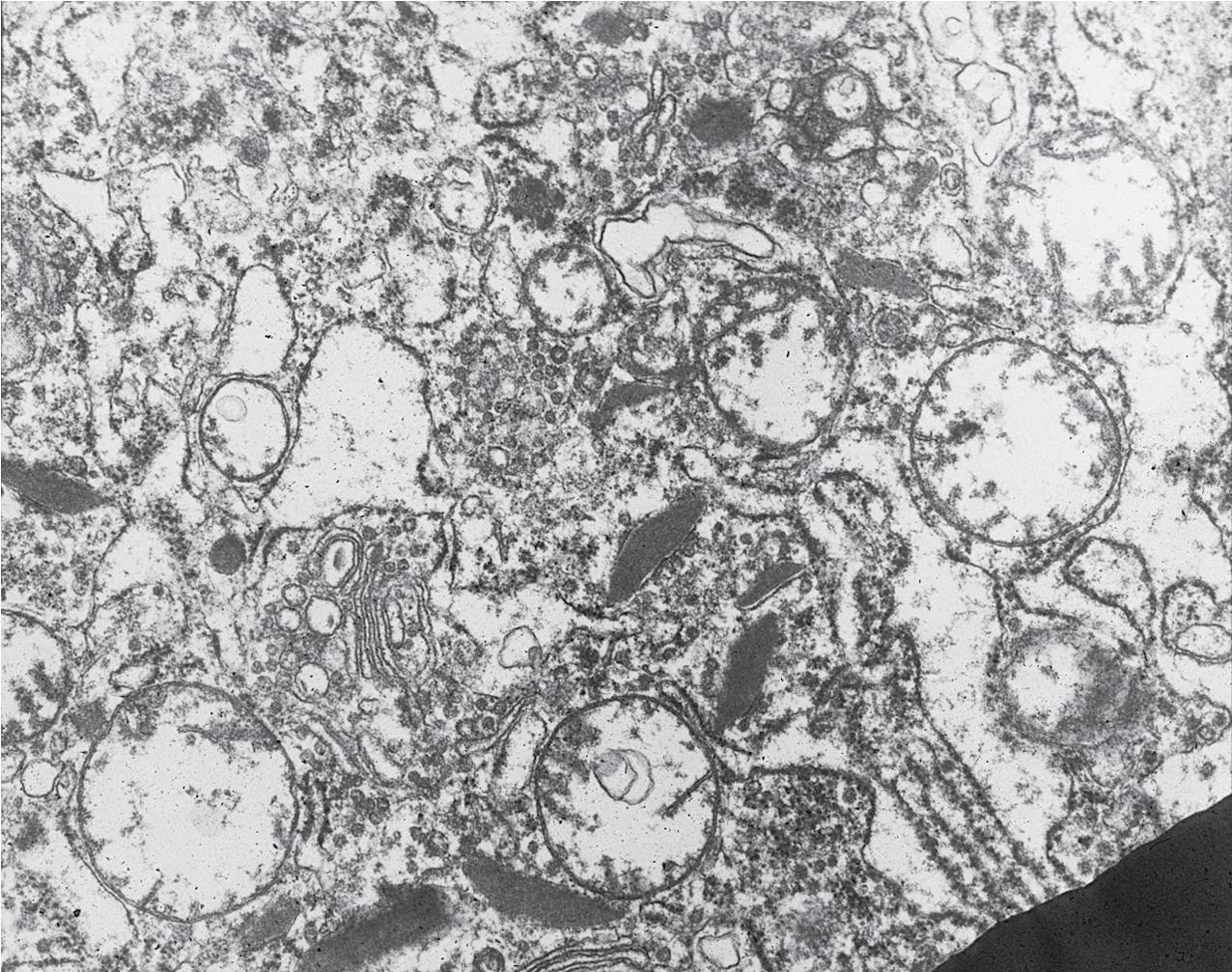
Approximately 2% of all new cancer cases worldwide originate in the kidney. RCC affects male patients approximately twice as often as female patients. RCC has been linked to acquired cystic kidney disease and ESRD. Although most cases are sporadic, 2% to 4% have a familial cause and are notably prevalent in individuals with von Hippel-Lindau (VHL) disease. RCCs vary widely in size, ranging from 1 to 2 cm to massive tumors weighing several times the weight of the normal kidney. They are usually unilateral and unicentric. Bilaterality and multicentricity are features of hereditary carcinomas. Prognosis is highly variable and depends on subtype, grade, and stage.
RCCs are typically solid, ovulated masses that bulge into the renal parenchyma. Although they may appear circumscribed, they frequently infiltrate the perinephric tissues and invade the vasculature, predominately the venous structures. An orange-yellow coloration is typical of the clear cell type, which often has foci of necrosis and scattered areas of hemorrhage ( Fig. 10.6 ). Chromophilic tumors may give a more friable, crumbling appearance.
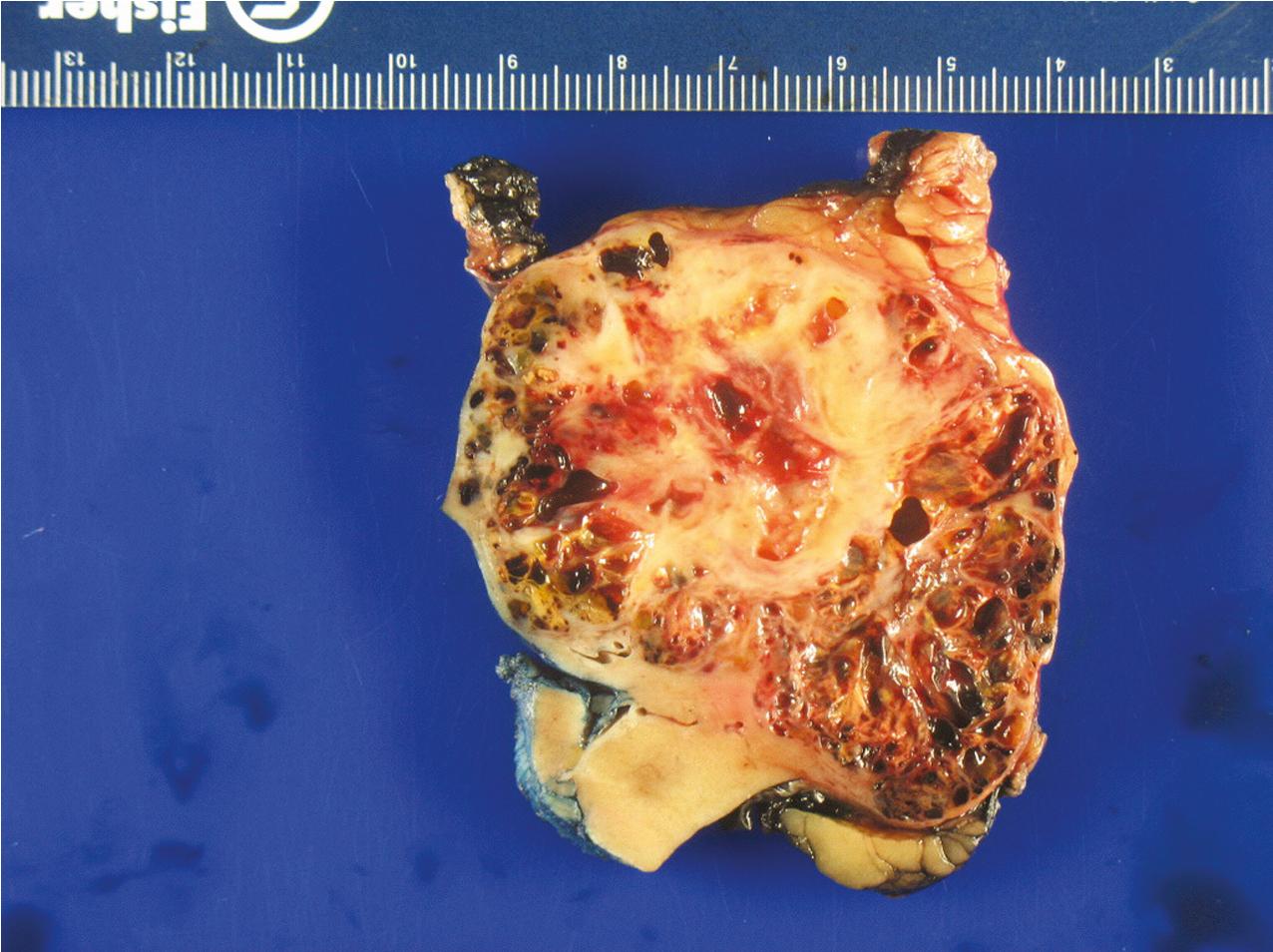
Microscopically, RCCs have a great diversity of patterns, as outlined in the 2016 WHO classification, which includes several new entities based on genetic profiles and syndromic associations (see Table 10.1 ). They may be diffuse, tubular, cystic, papillary, or sarcomatoid. Because the kidney is derived from the mesenchyme, the sarcomatoid tumors have features that resemble leiomyosarcomas or fibrosarcomas. The new WHO/International Society of Urologic Pathologists (ISUP) grades are based either on nucleolar prominence (grades 1–3) or the presence of nuclear pleomorphism, tumor giant cells, and/or rhabdoid or sarcomatoid differentiation (grade 4; Table 10.2 ) and are used as prognostic indicators in clear cell and papillary renal cell carcinomas. Ultrastructurally, clear cell RCC contains abundant lipid and glycogen, whereas chromophobe RCC is characterized by the presence of abundant intracytoplasmic vesicles ( Figs. 10.7–10.22 ).
| Grade 1 | Tumor cell nucleoli absent or inconspicuous and basophilic at 400x magnification. |
| Grade 2 | Tumor cell nucleoli conspicuous and eosinophilic at 400x magnification and visible but not prominent at 100x magnification. |
| Grade 3 | Tumor cell nucleoli conspicuous and eosinophilic at 100x magnification. |
| Grade 4 | Extreme nuclear pleomorphism, tumor giant cells, and/or sarcomatoid or rhabdoid morphology. |
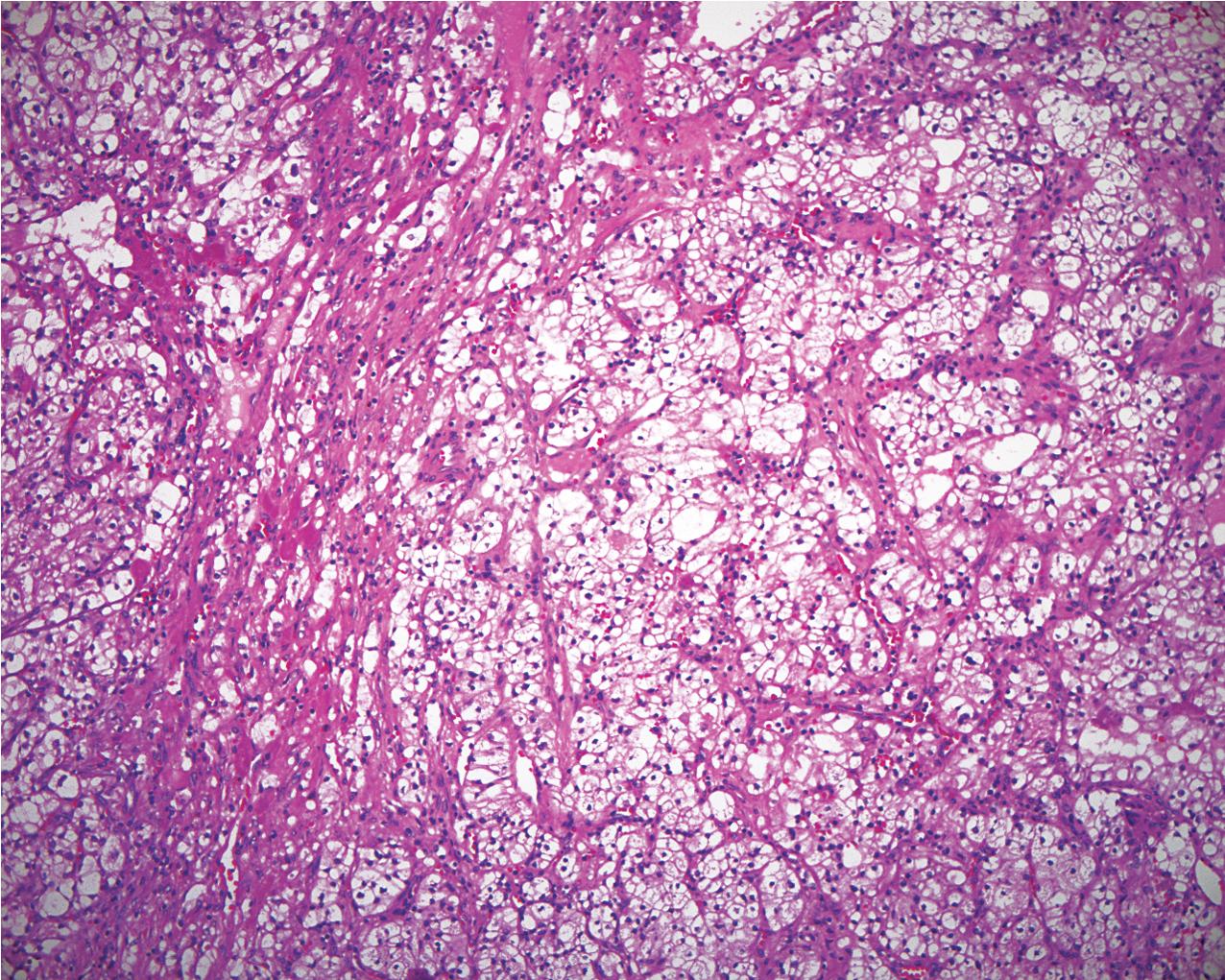
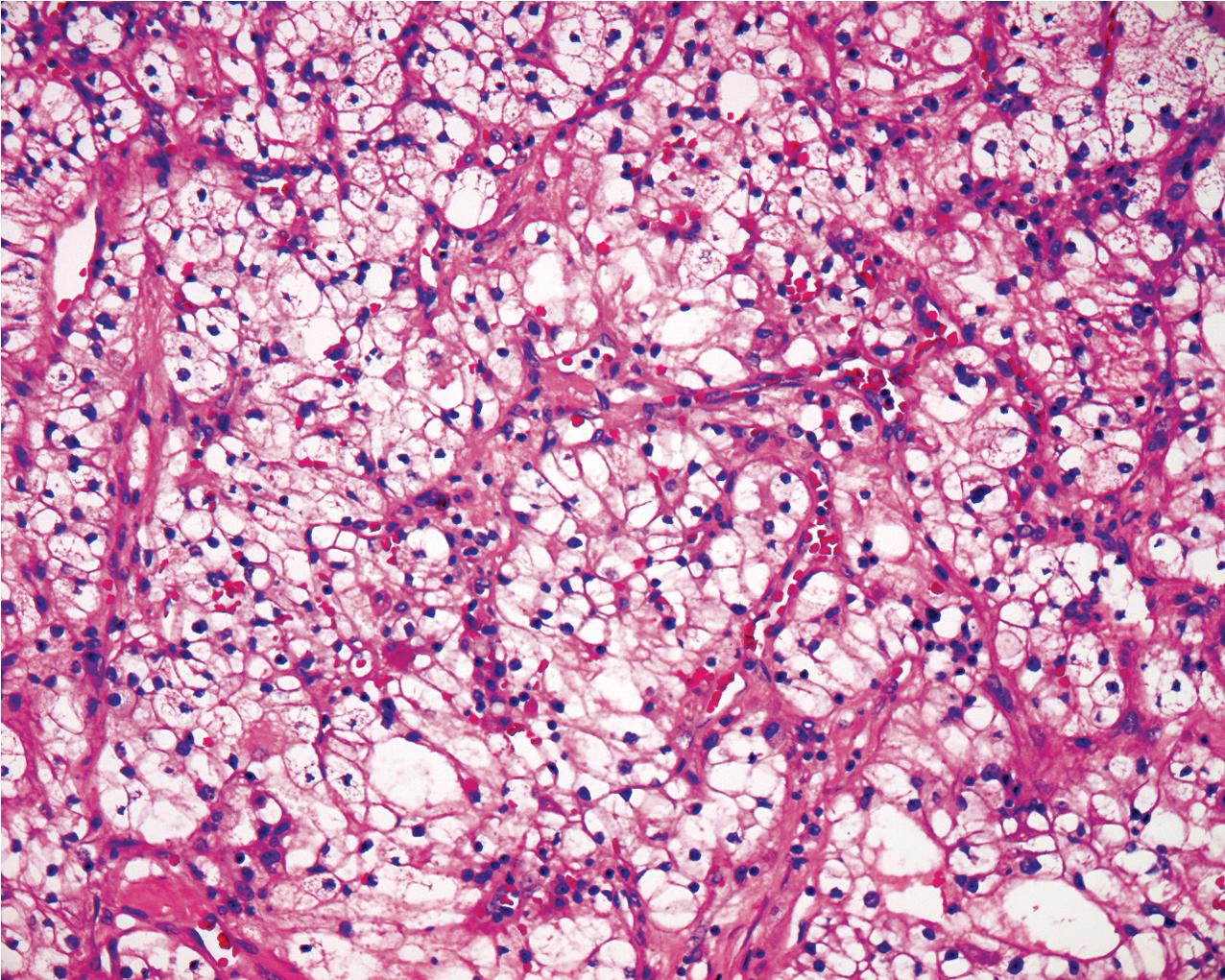
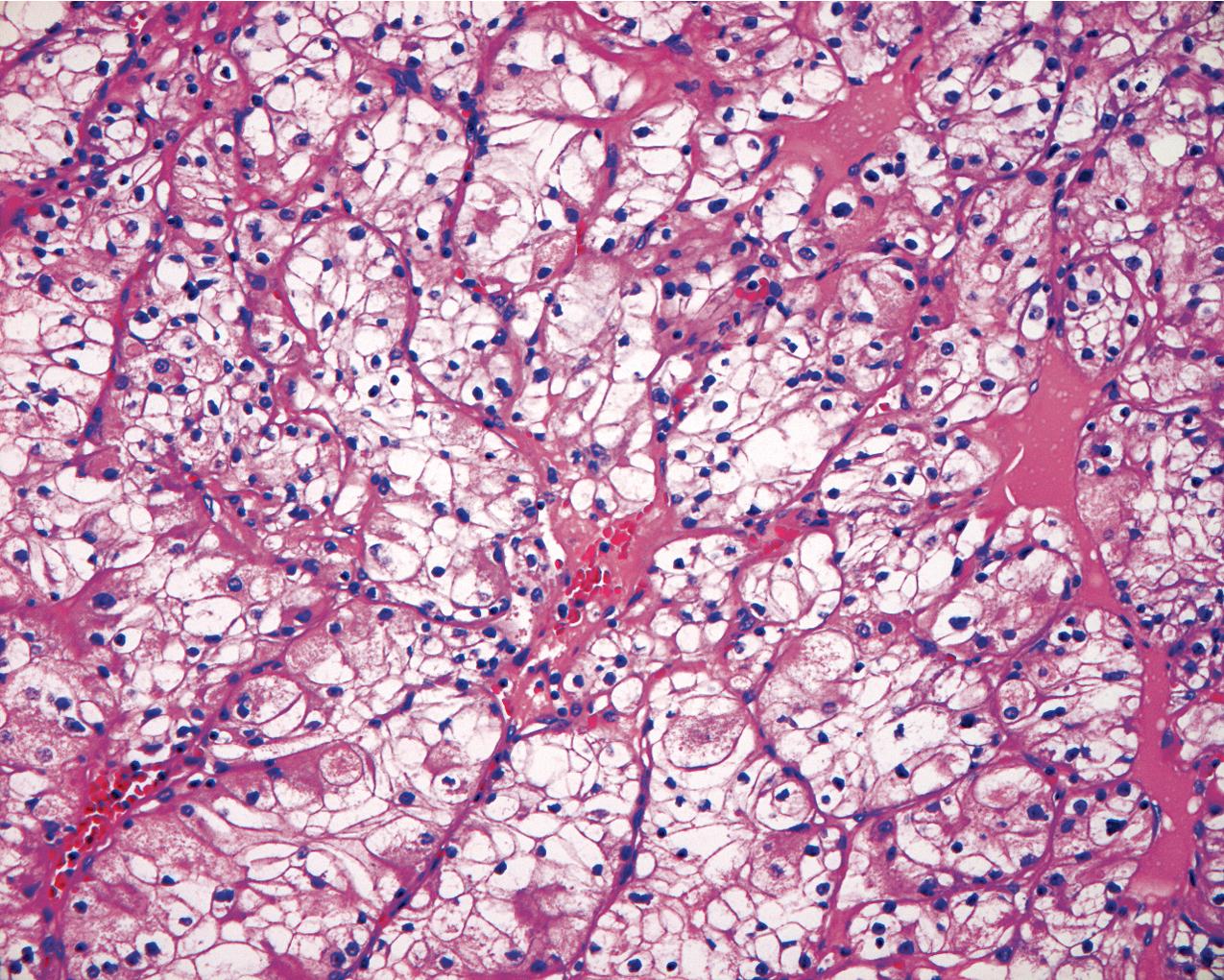
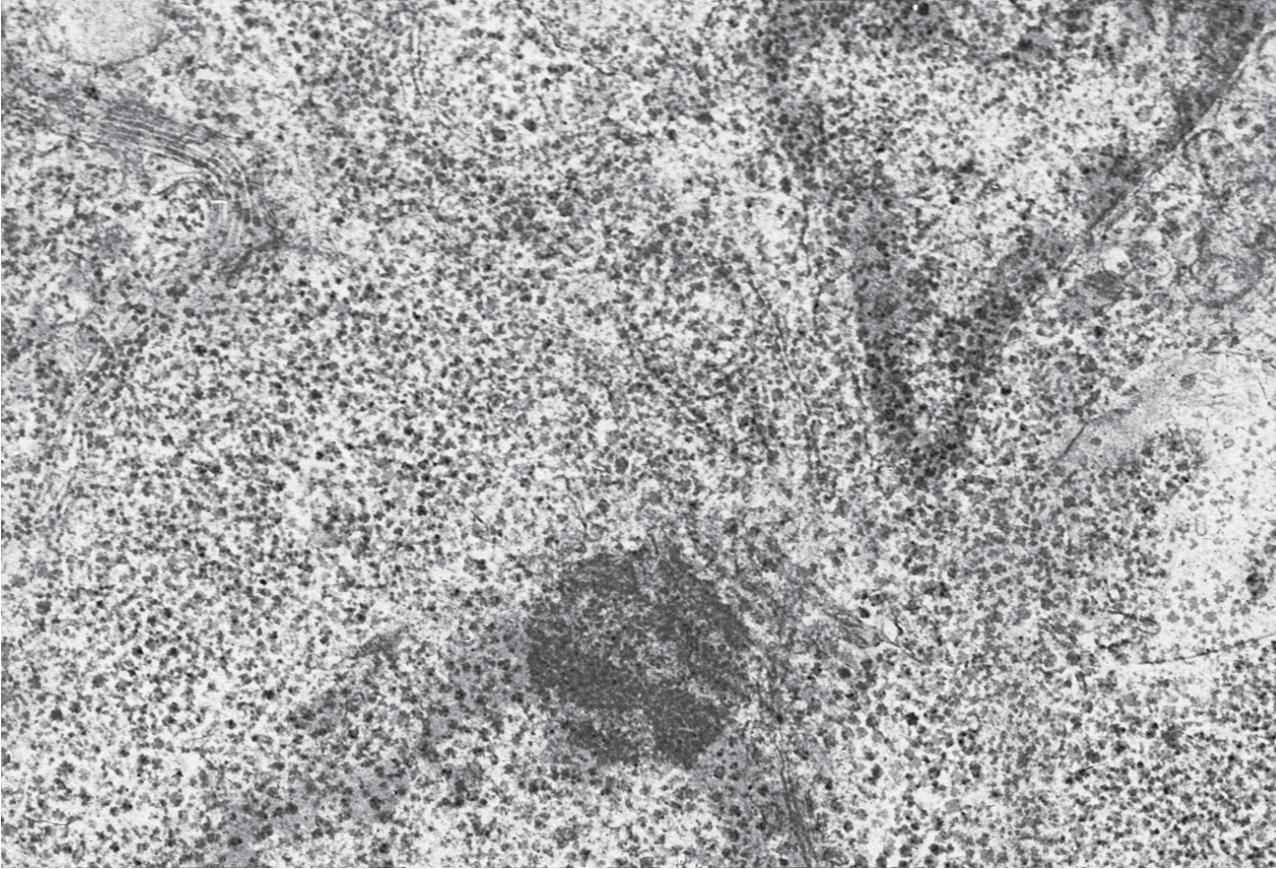
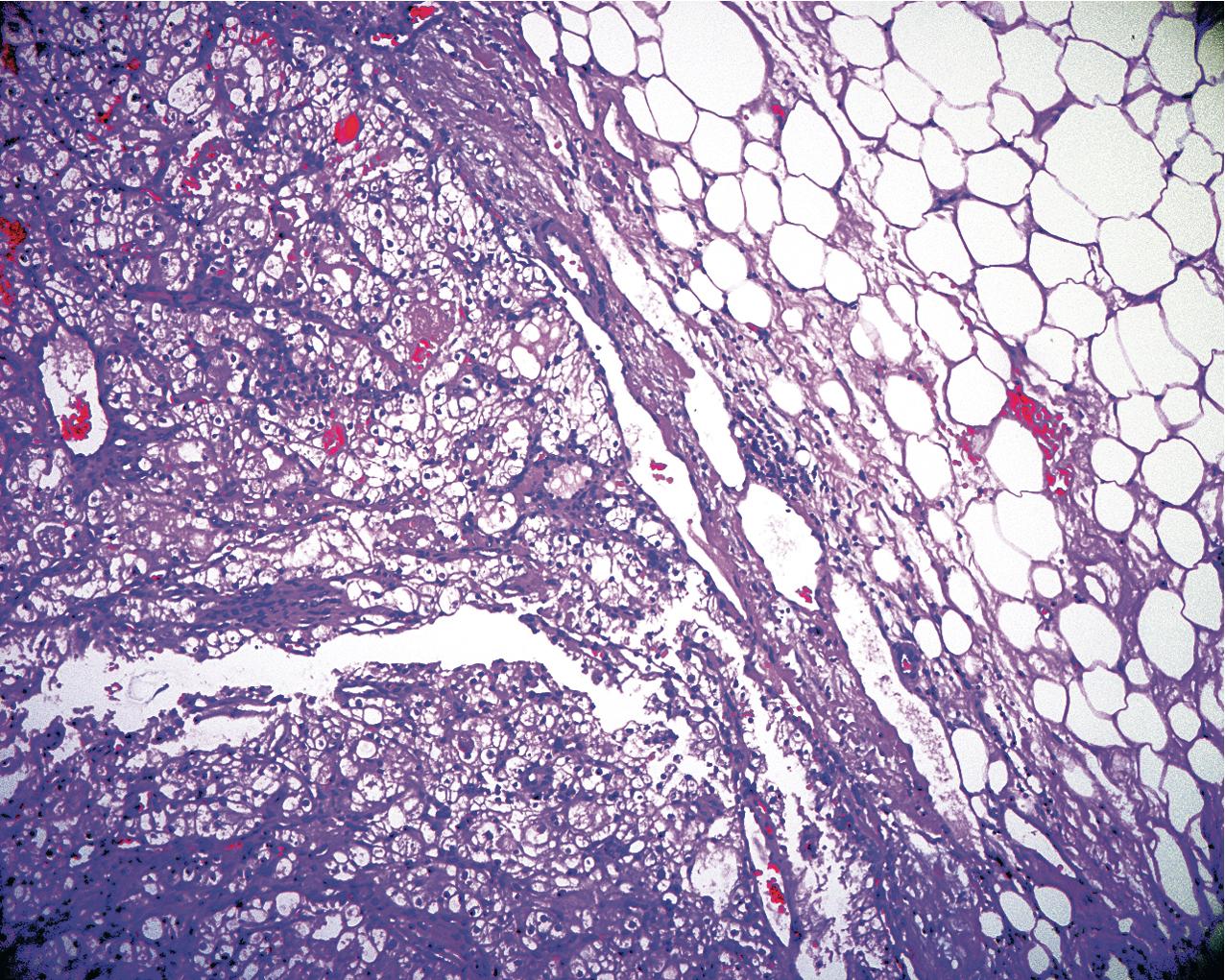
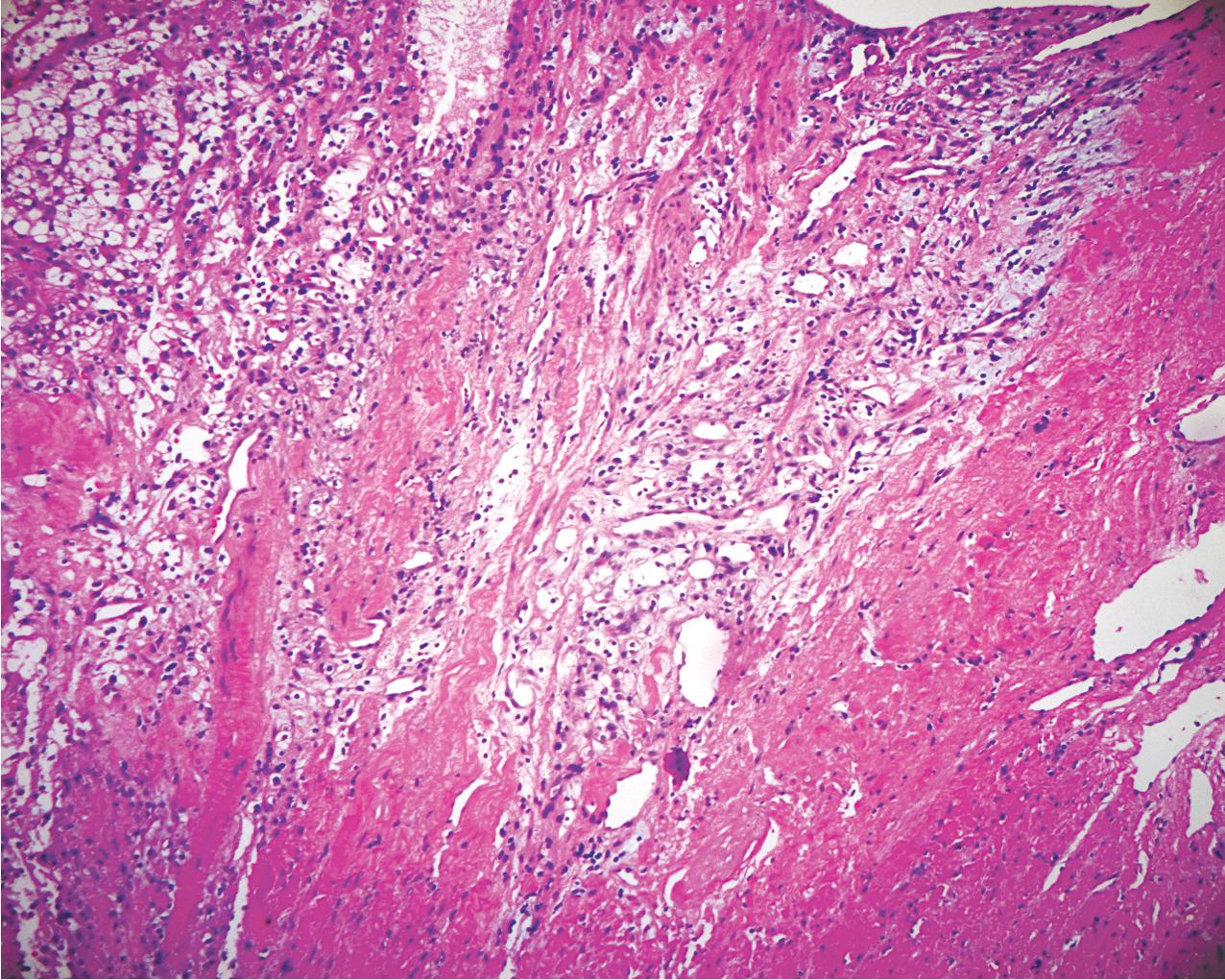
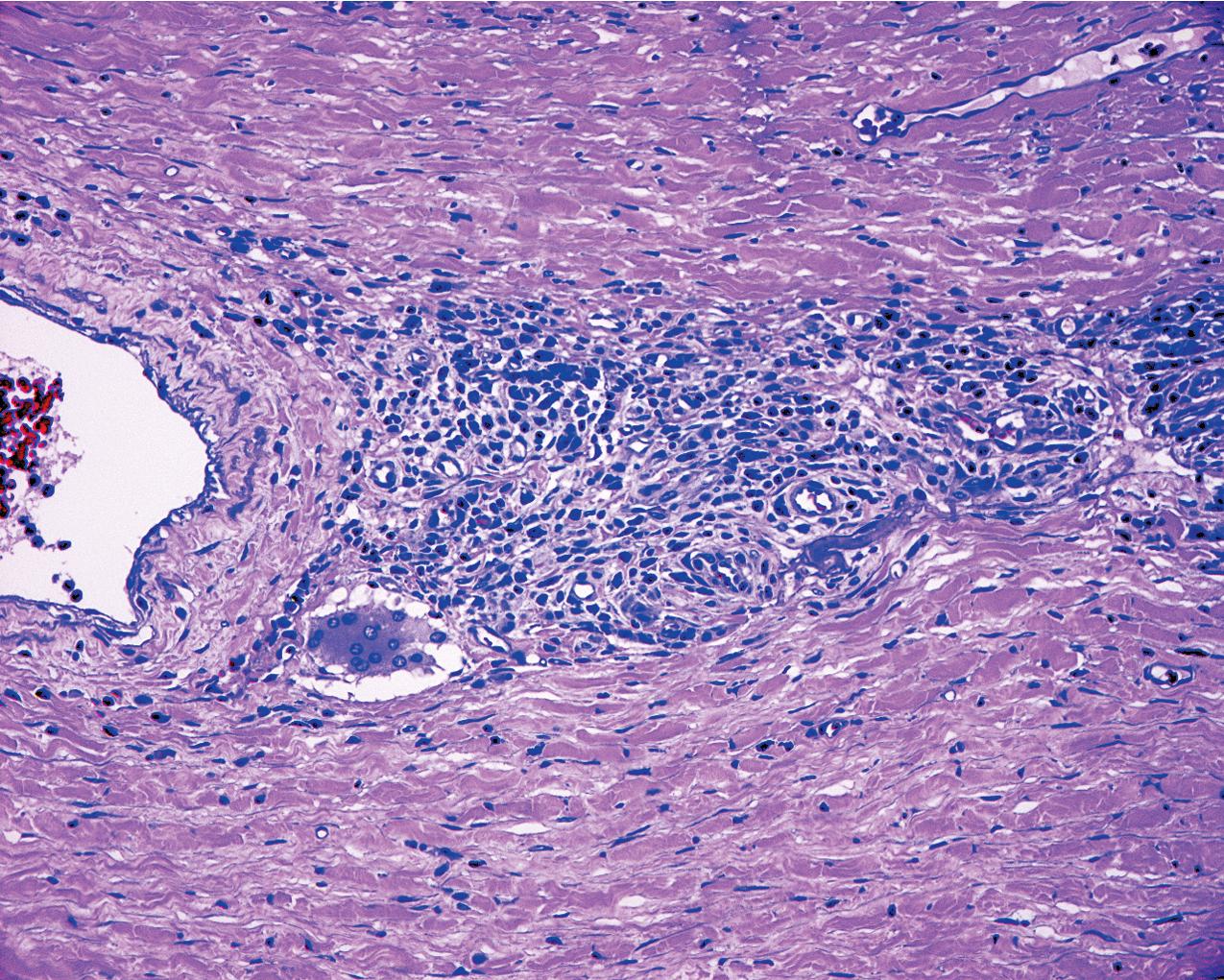
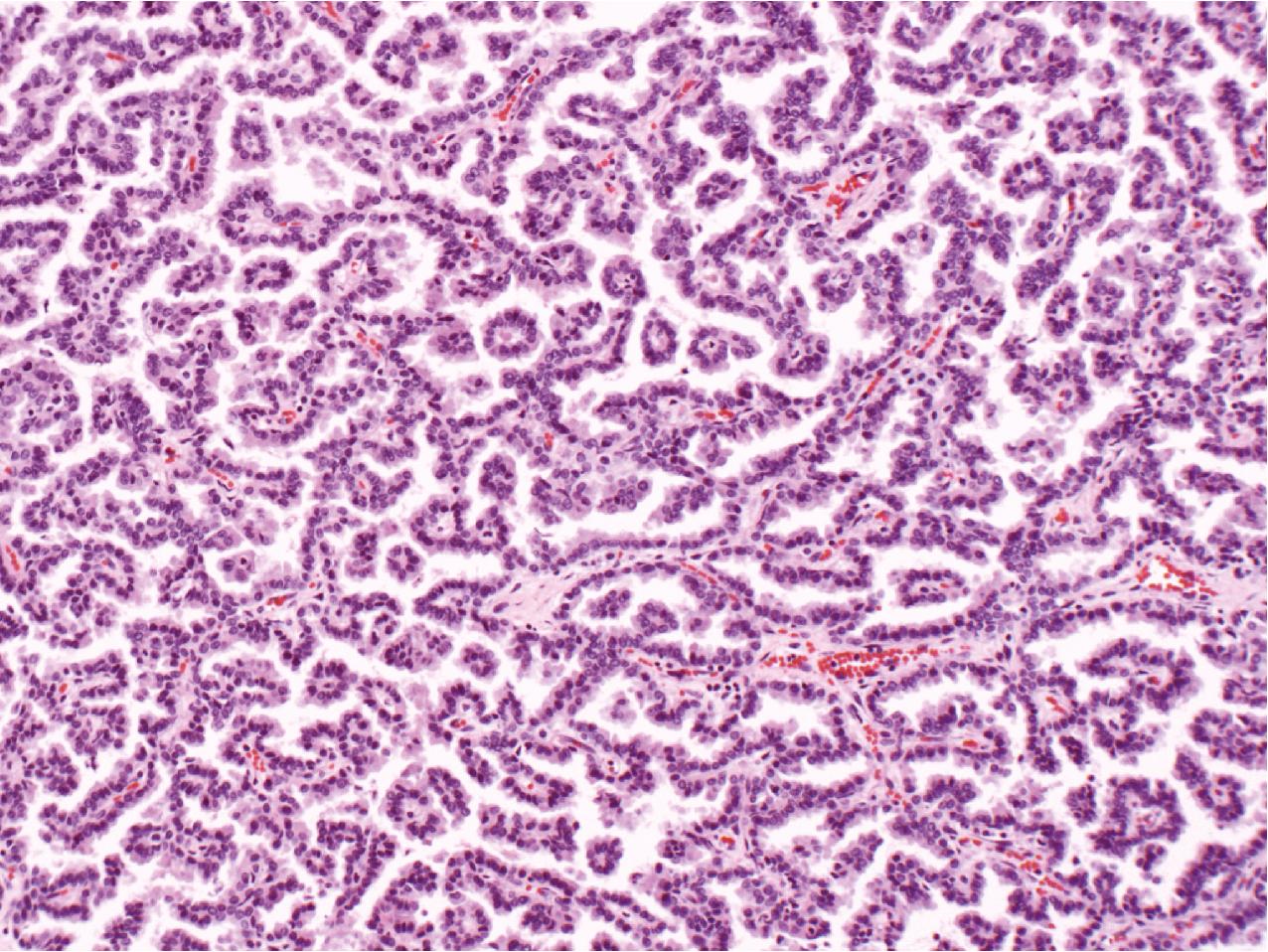
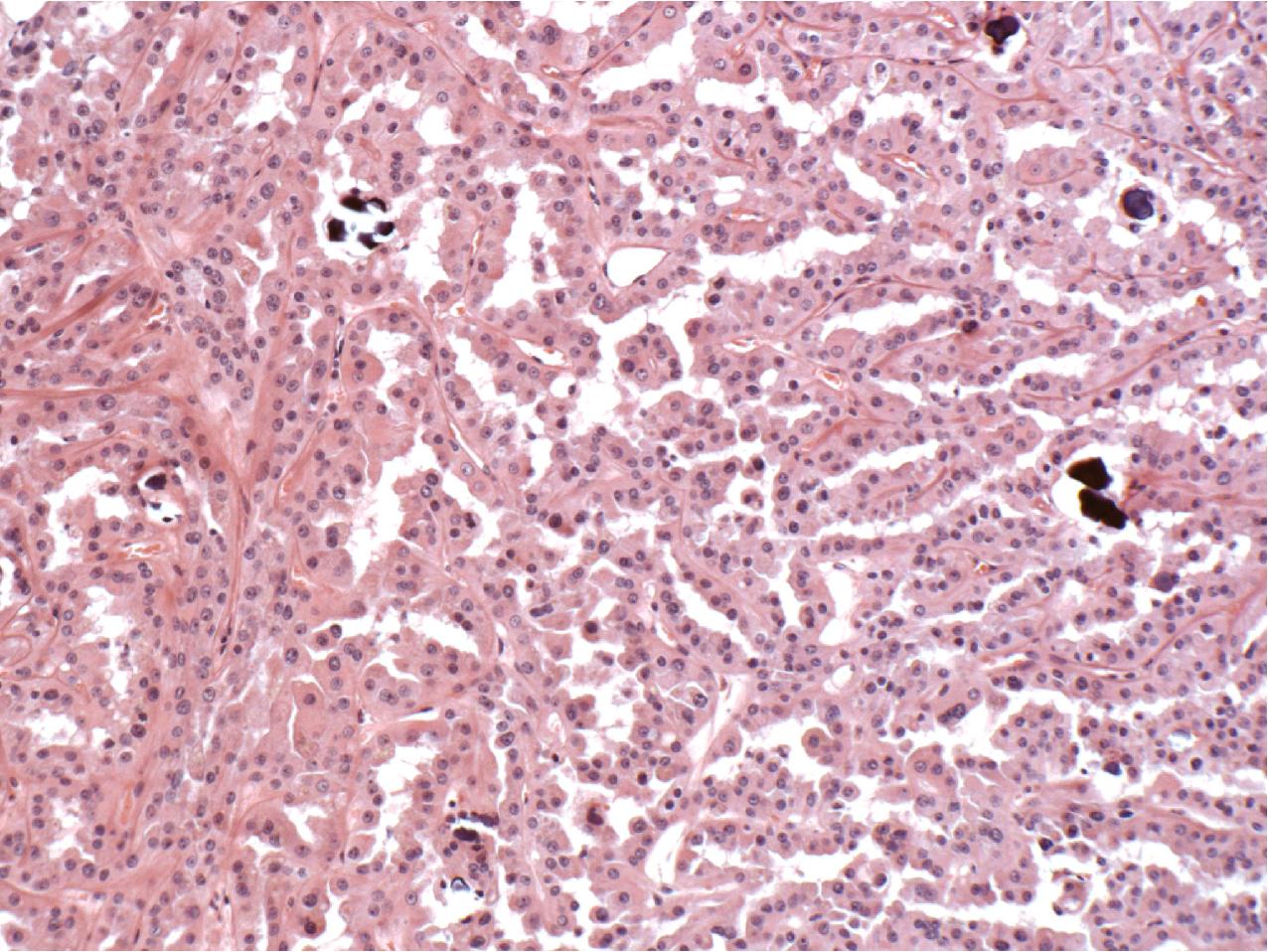
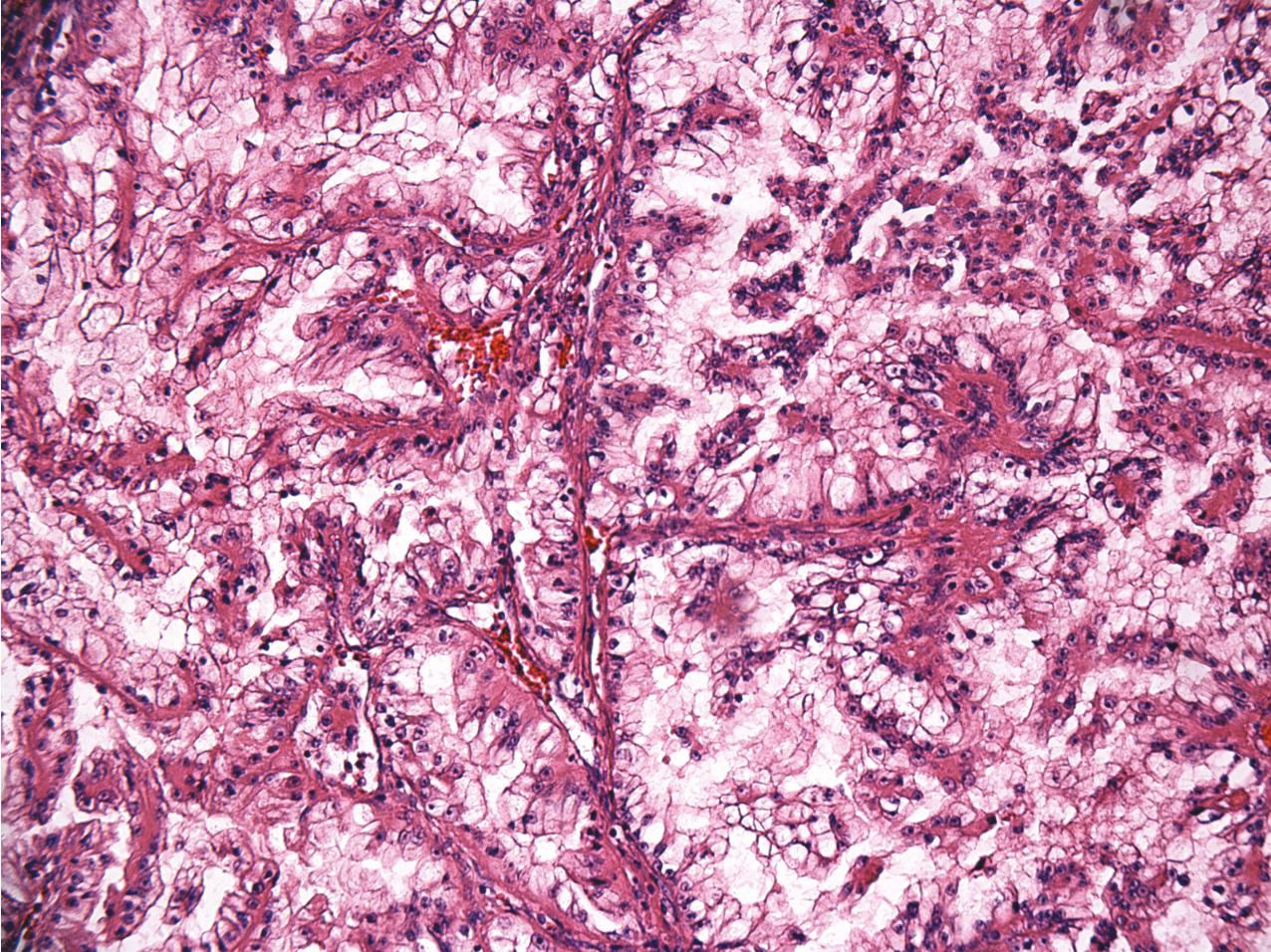
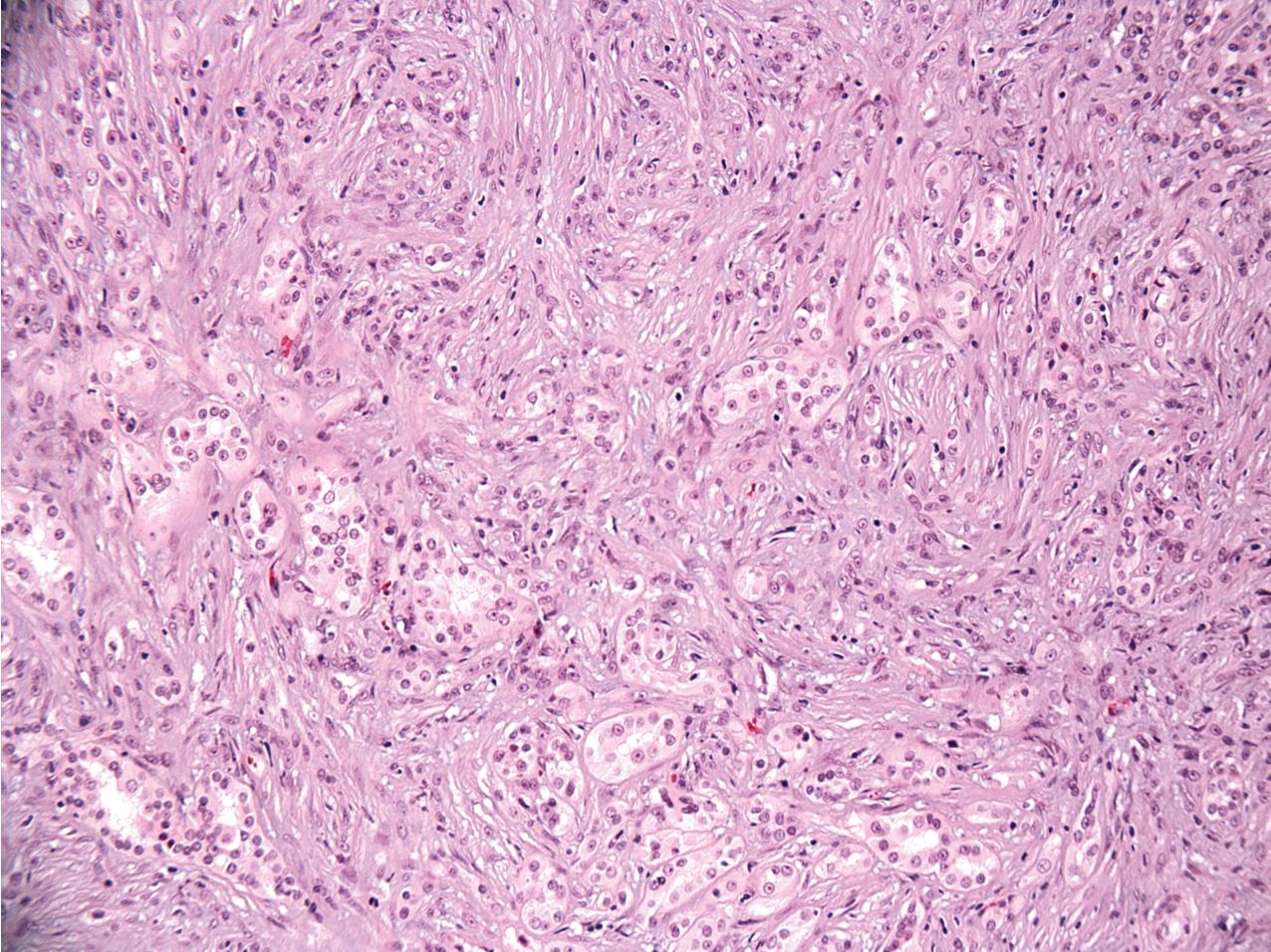
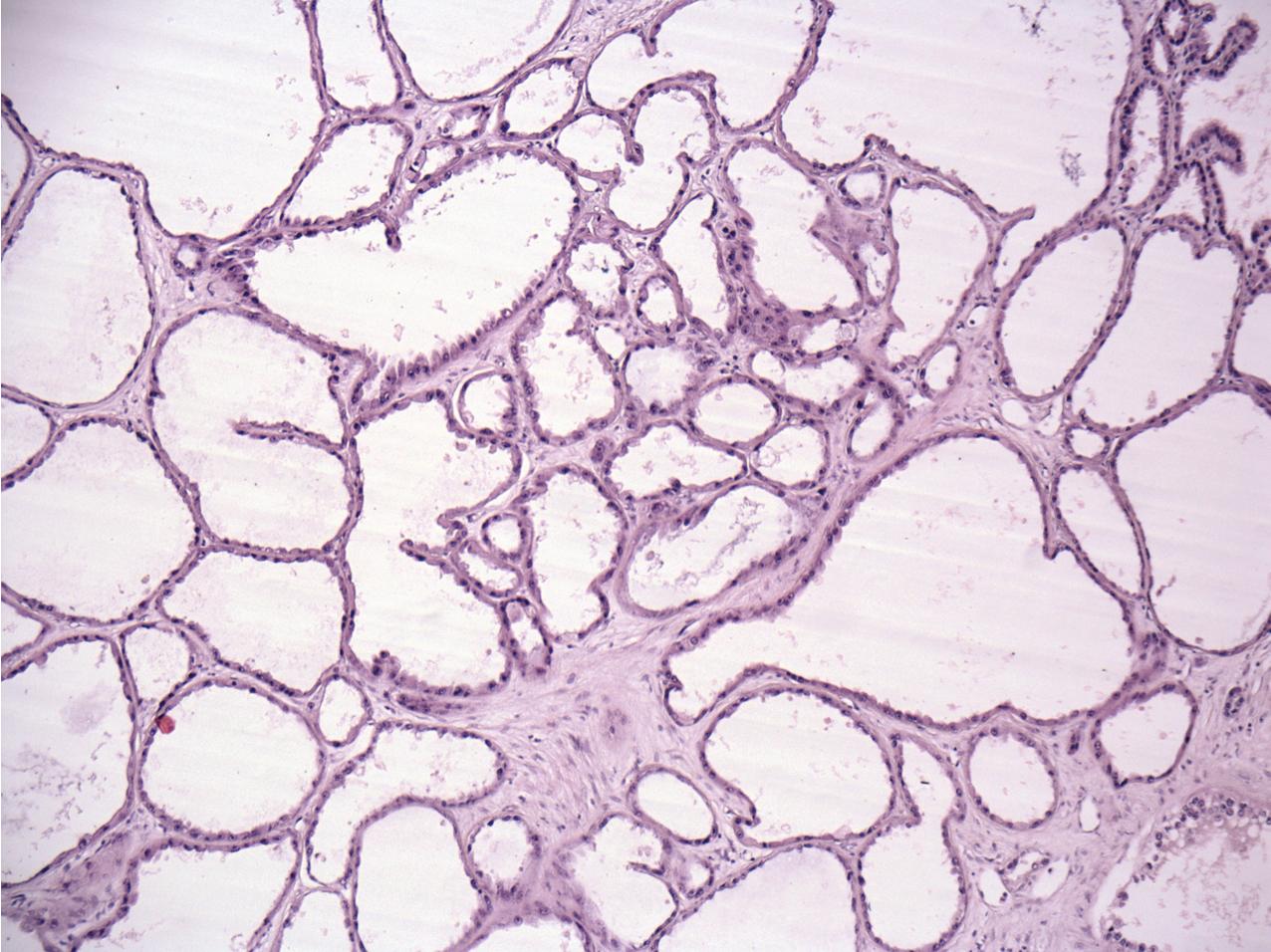
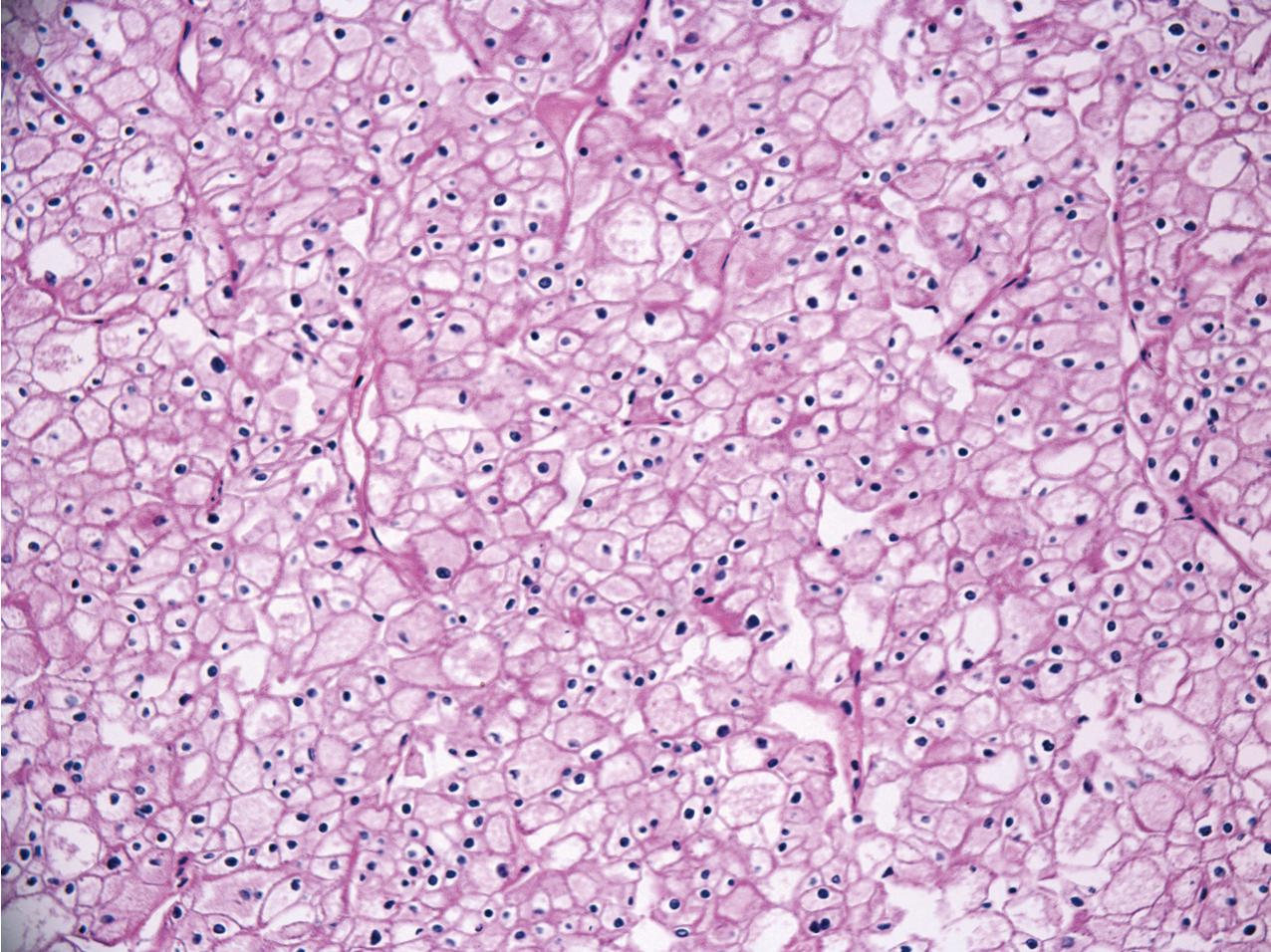
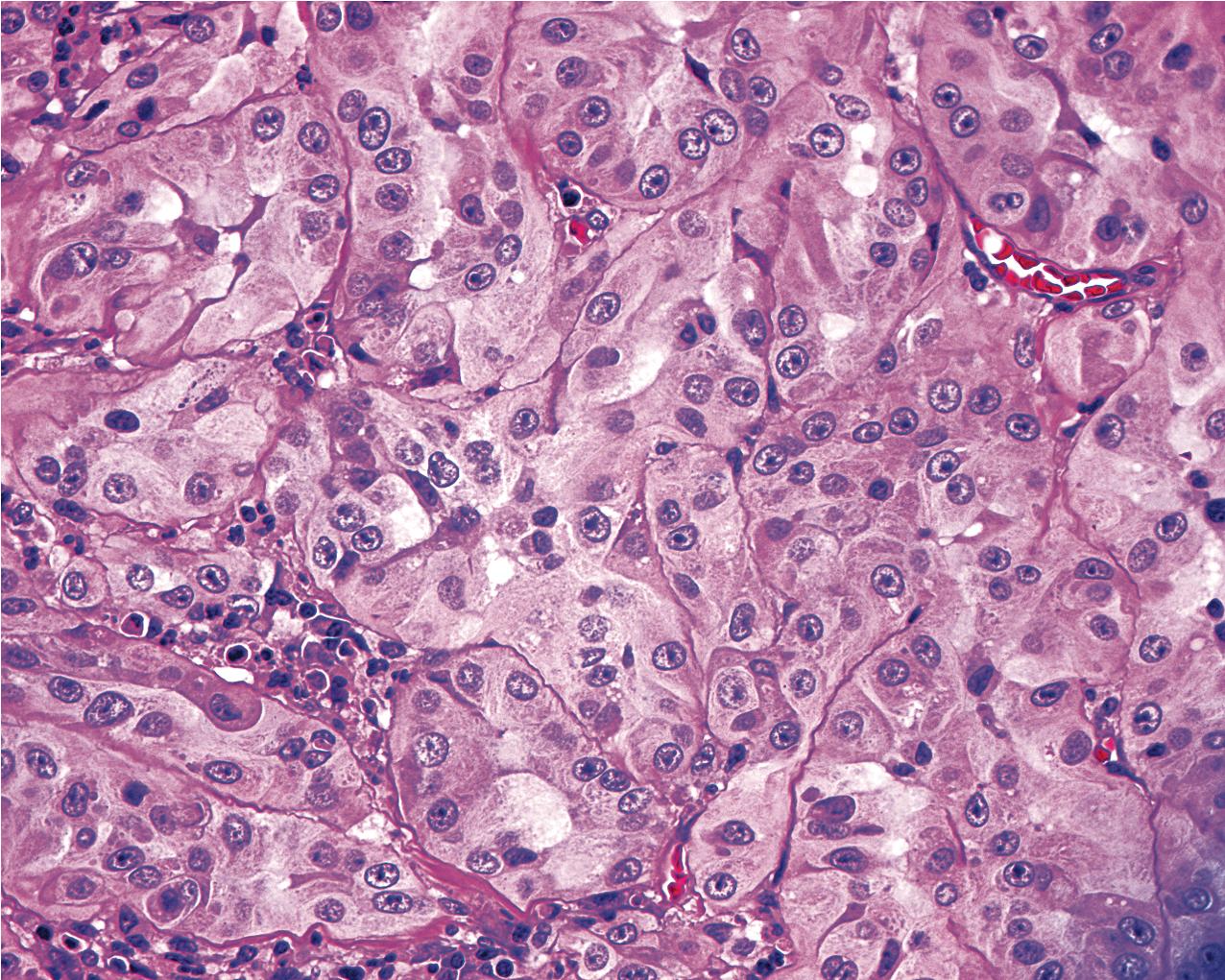
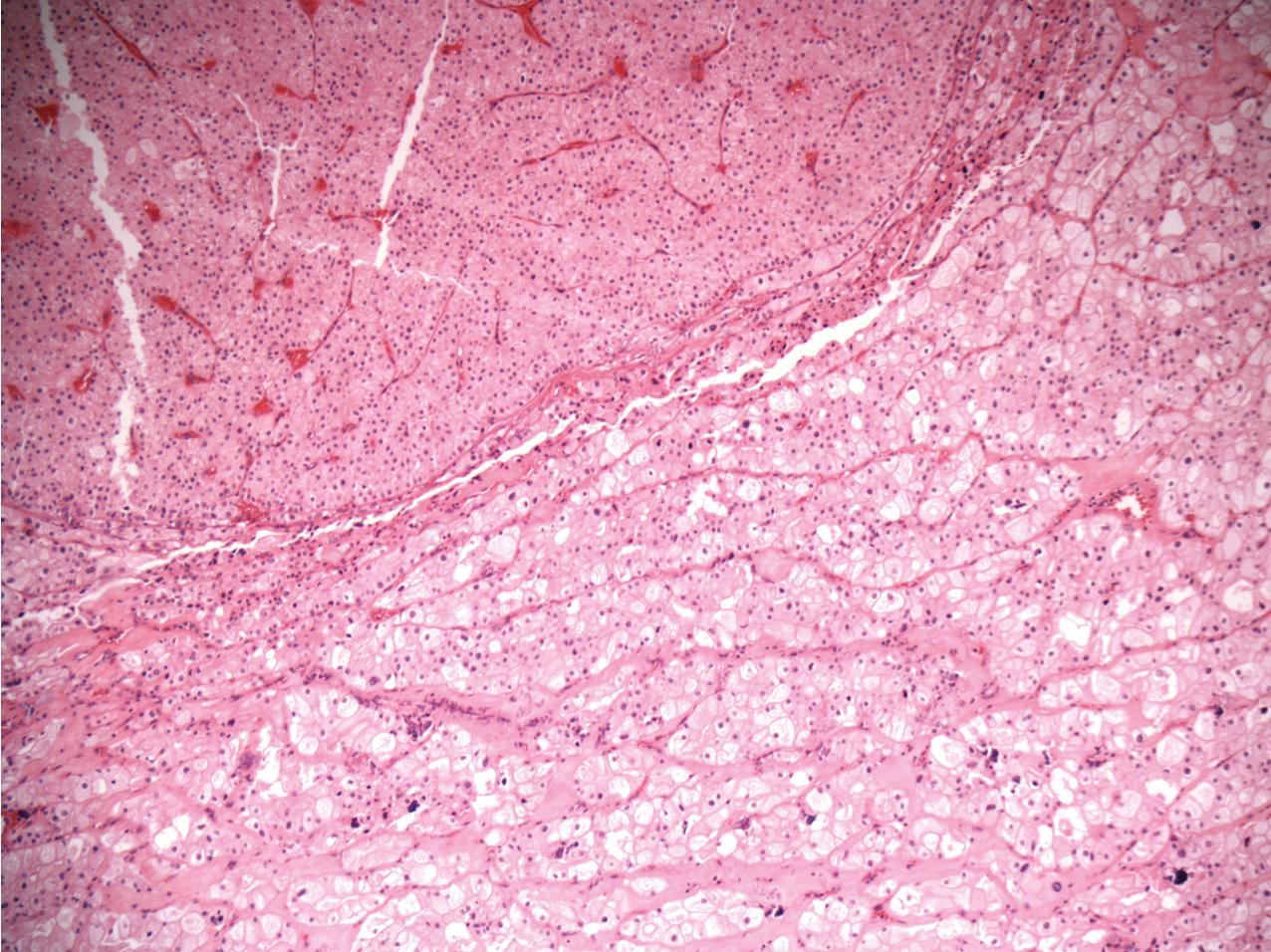
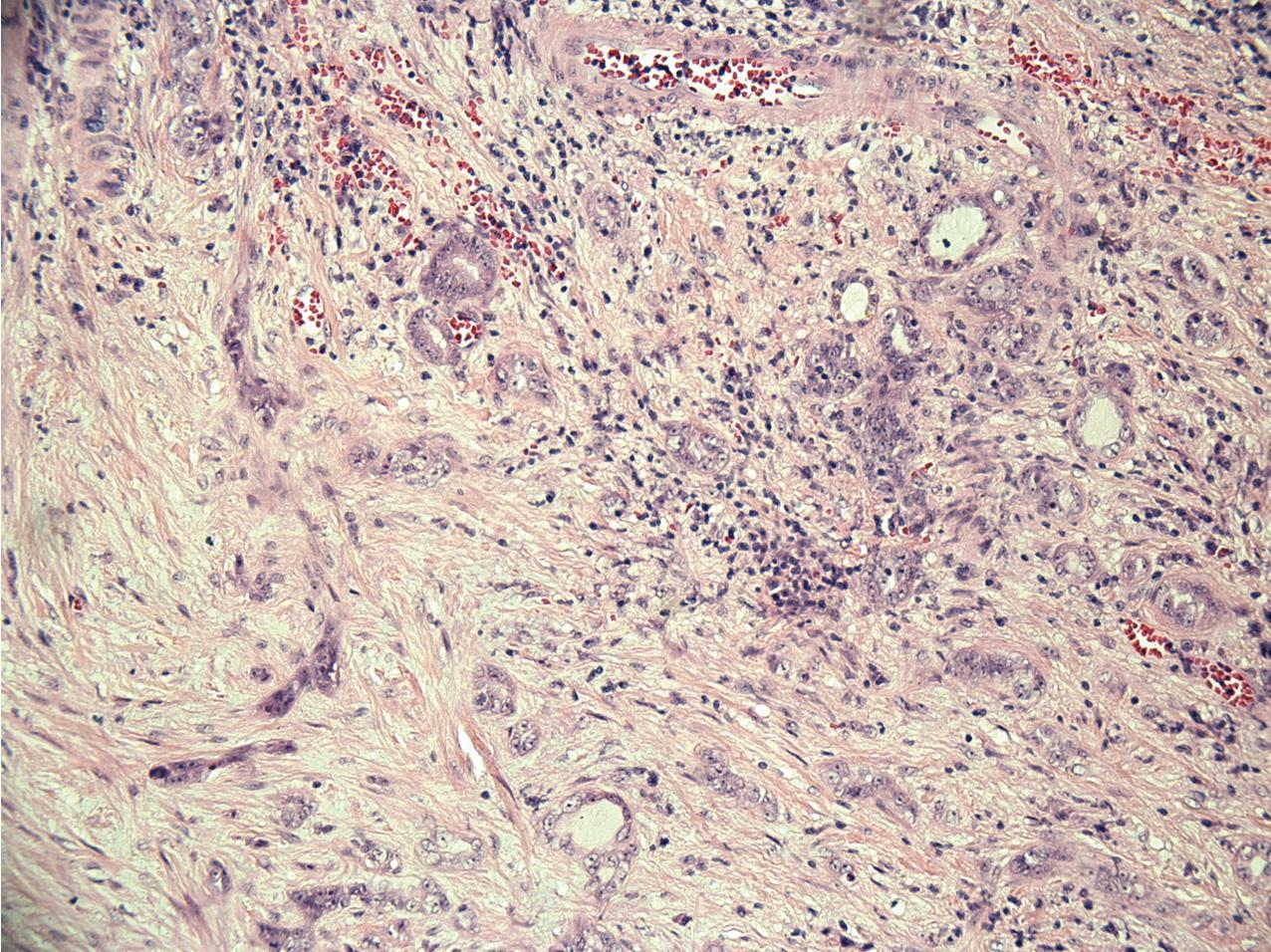
The College of American Pathologists (CAP) has provided standards for the reporting of surgical resections of renal tumors. These standards provide a synopsis of cancer pathology staging and prognostic and predictive parameters ( Tables 10.3–10.5 ). The standards can be accessed on the organization’s website (CAP.org). They include macroscopic and microscopic grading and staging in a standard format. They also include a specific section describing the pathology of the nonneoplastic kidney that should identify evidence of medical renal disease involvement. Glomerular, tubulointerstitial, and vascular changes should be described and interpreted.
| Primary tumor (T) |
|
| Regional lymph nodes (N) |
|
| Distant metastases (M) |
|
| Stage | Tumor | Node | Metastasis |
|---|---|---|---|
| Stage I | T1 | N0 | M0 |
| Stage II | T2 | N0 | M0 |
| Stage III | T1 or T2 | N1 | M0 |
| T3 | N0, N1 | M0 | |
| Stage IV | T4 | Any N | M0 |
| Any T | Any N | M1 |
|
Become a Clinical Tree membership for Full access and enjoy Unlimited articles
If you are a member. Log in here